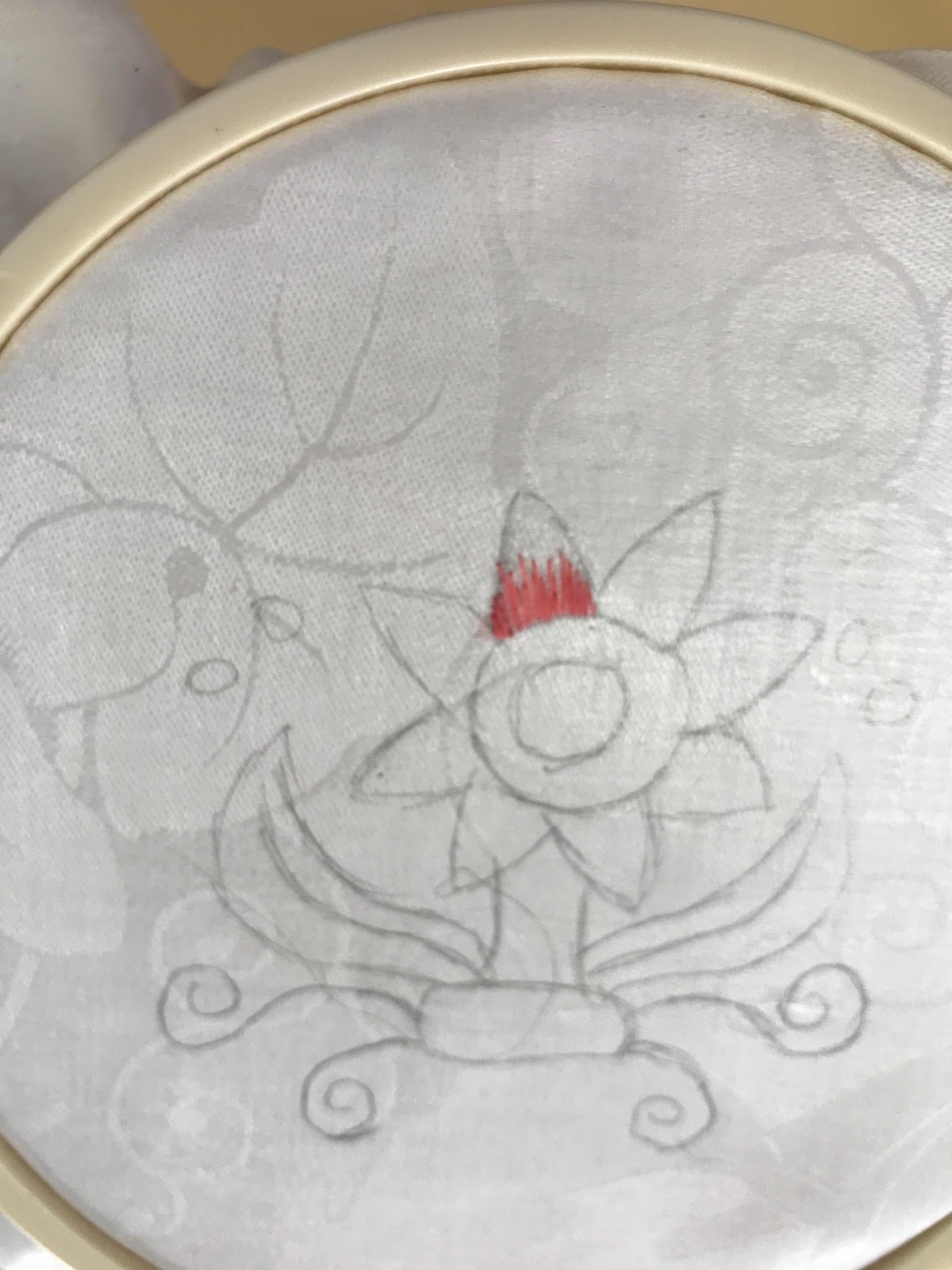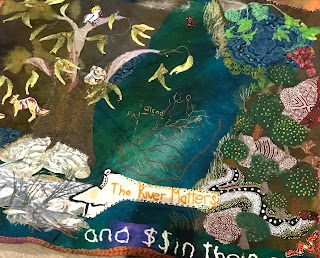This is an unusually long post - recording the work of several months to create my entry in the Guild's SALA Exhibition, which opened tonight. SALA, the festival of South Australian Living Arts, is held in August. Entries in SALA have to be original. The Guild Exhibition is on until 11 August.
The Guild theme is 'a celebration of water'. The organising committee has printed some sea dragons, sea horses and water lilies on to fabric blocks which can be purchased, embroidered and developed in original ways. I bought some, but then I had another idea.
A conversation with my brother drew my attention to lines in John Williamson's 1988 song It's a way of life,
With cotton in their ears and dollars in their eyes
Their banker grins and our country dies.
Last SALA exhibition the Guild's theme was 'Aviarius'' and I made a quilt around the song When the red, red robin. When a friend at the Guild asked me if I was going to embroider a song again, I formed the idea of creating something using John Williamson's words, in the light of the water crisis in the Murray River basin. We surely need to celebrate the life-giving river system as we seek to restore it.
In my stash I had a couple of felt flimsies I had purchased from Dale Rollinson. They were not the right colour for a river project, but they had potential in size and texture, so I searched Dale's Thread Studio site and ordered four more. When they arrived, I selected 'ironbark' as my background and 'emerald' for the river. This is the river affected by blue-green algae. I set aside the others for the back.
I practiced Quaker stitch on the lettering, initially using Appleton's wool, which I doubled to get enough coverage.
 I then switched to tapestry wool, which worked better.
I then switched to tapestry wool, which worked better.
It was hard to keep the lettering straight on the felt flimsies. The lines and letters I marked with chalk disappeared into the felt within minutes. Even when I tacked lines the felt shifted as I stitched. I don't, however, mind the crude look.
I looked at a lot of photographs of the Murray-Darling river system and made a rough sketch of my design.
I wanted to show the connection of the river to land and life and the impact of the greedy use of water. I thought of using various Aboriginal words and symbols for water but decided I did not have the authority or permission to do this. Instead, I thought I could use Aboriginal fabric. I figured that this was commercial product, and therefore in the public domain, available for incorporation.
I also searched for Aboriginal designed fabric with water themes and ordered pieces called Baanbaan, On Walkabout, Waterhole brown, Possum land and water blue from Aboriginal Fabric Gallery in Alice Springs. They were immensely helpful, rushing fabric to me before Easter. I also bought Dancing Spirit Brown and Snake and Emu from the One Stop Fabric Shop.
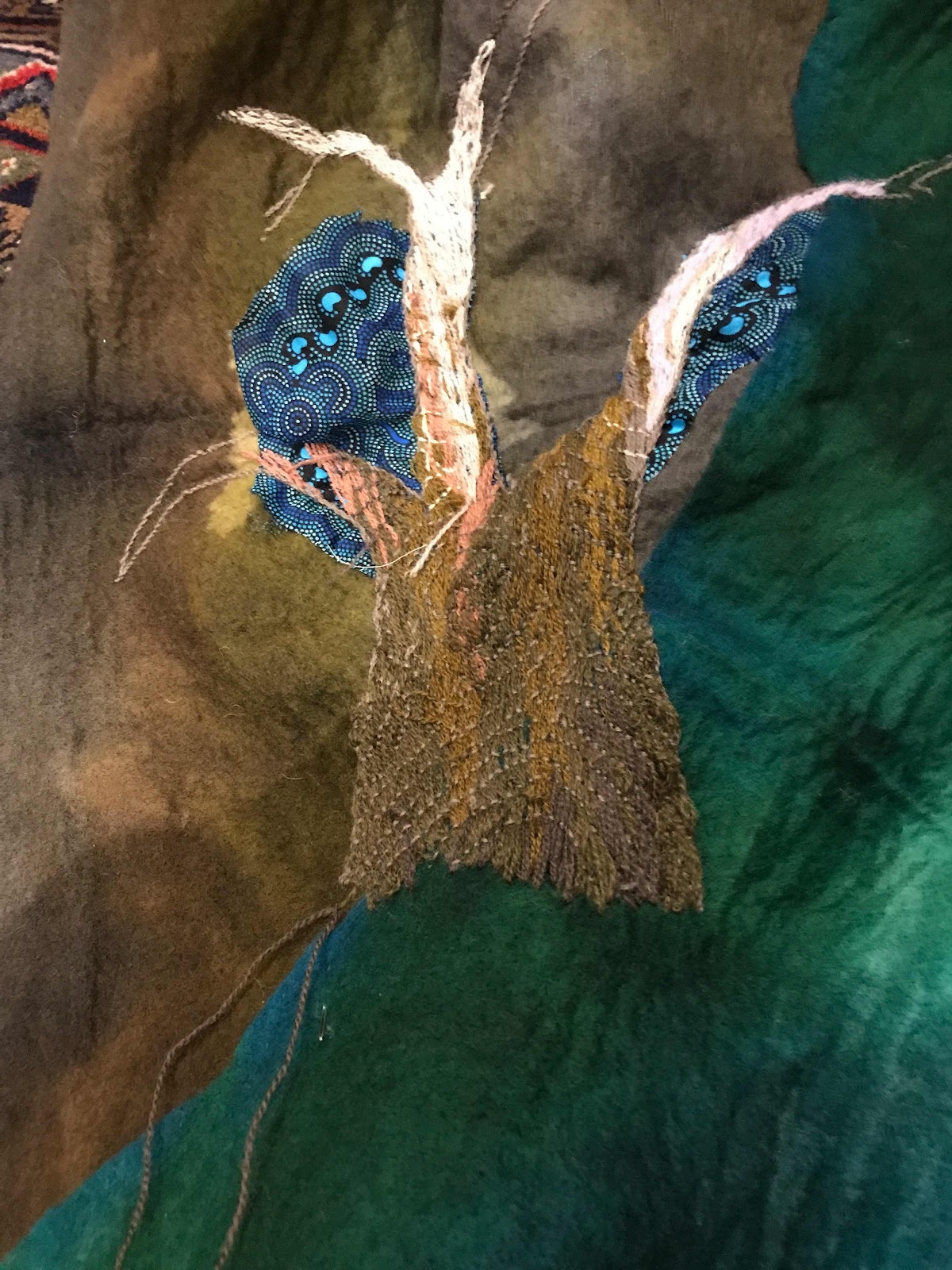 Over Easter I appliquéd, a few pieces of fabric to the flimsy and then embroidered a large tree overhanging the river.
Over Easter I appliquéd, a few pieces of fabric to the flimsy and then embroidered a large tree overhanging the river.
I cut some gum leaves from another piece of fabric I found and appliquéd, them around the tree. It creates, I think, a good sense of a tree losing its leaves and beginning to die.
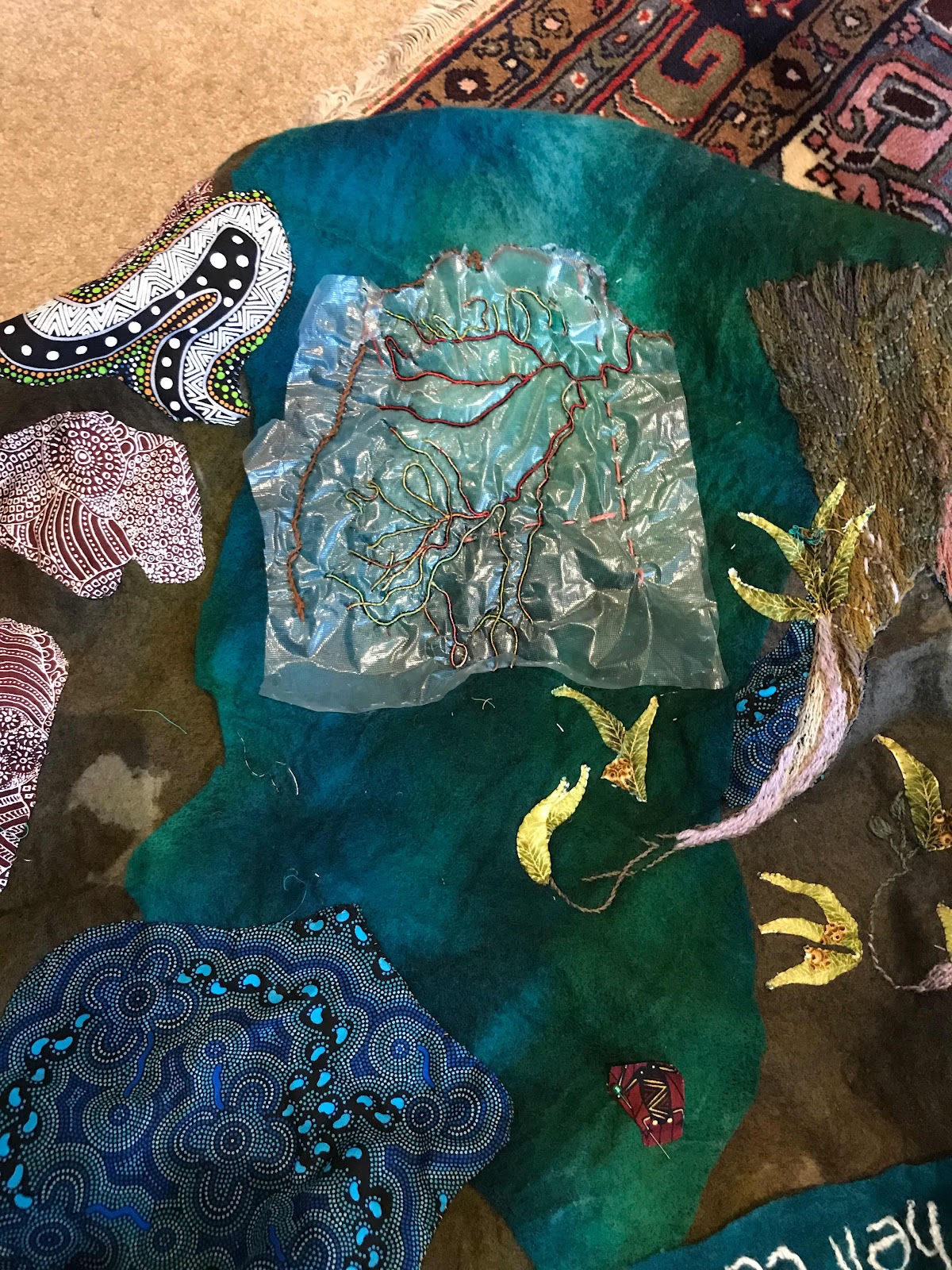
In the centre of the river felt I embroidered a map of the Murray-River basin, using gimp. The only way I could see to do this was using Solvi. The background is too soft and absorbent to use any marker. I don't much like stitching through a membrane but in this instance couldn't find another way.
I removed as much as the membrane as I could by tearing, rather than dampening the whole thing, as I wanted to wet as little as possible of the felt. It worked, but did need a bit of stitch repair afterwards.
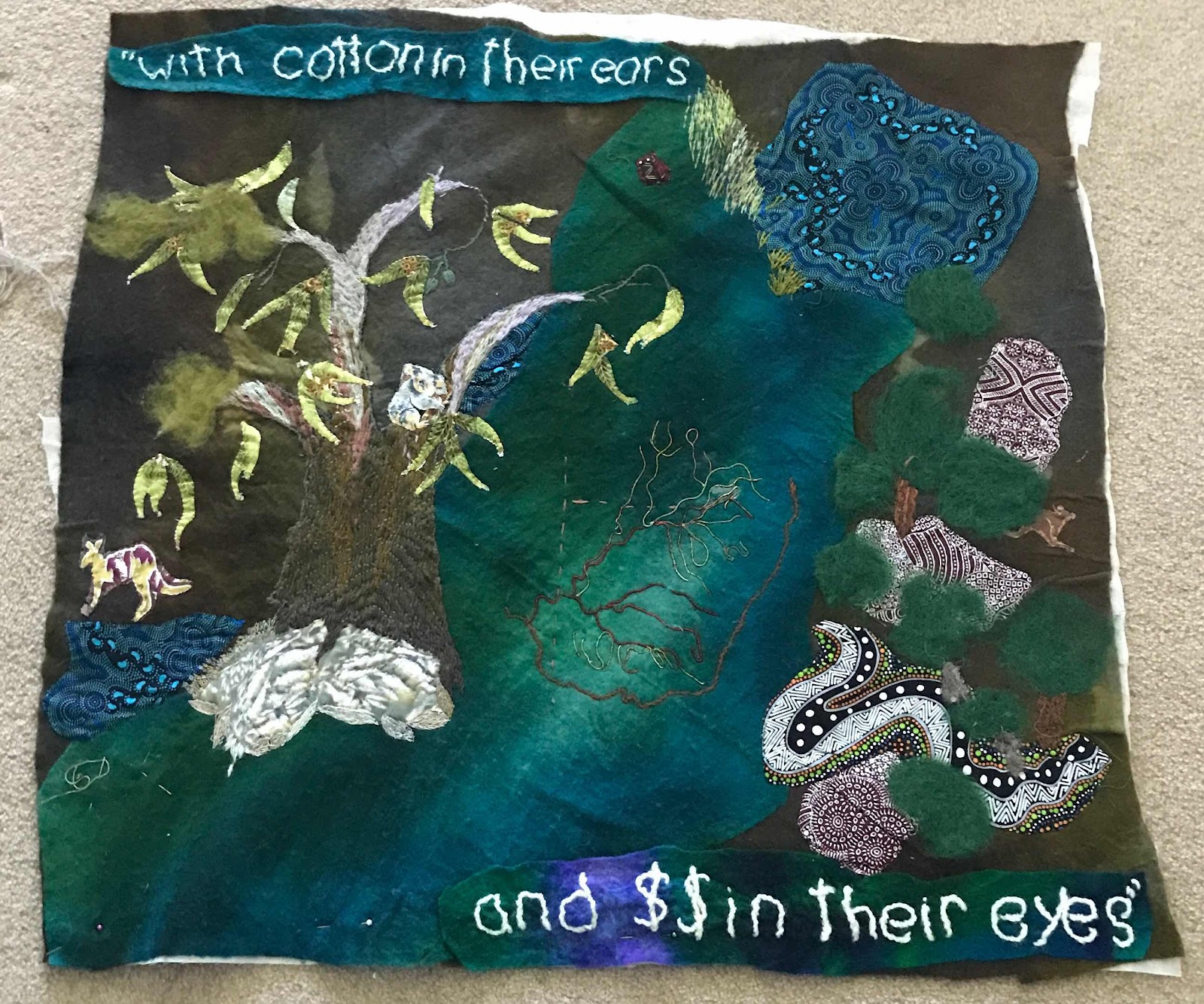 By now it was becoming apparent that the pre-felted flimsy was not sufficiently stable where I had embroidered the tree and appliquéd the leaves. I therefore applied some strips of iron-on interfacing to the back of the tree and needle-felted any areas of the flimsy that were sagging. I then applied a fine cotton backing the whole piece.
By now it was becoming apparent that the pre-felted flimsy was not sufficiently stable where I had embroidered the tree and appliquéd the leaves. I therefore applied some strips of iron-on interfacing to the back of the tree and needle-felted any areas of the flimsy that were sagging. I then applied a fine cotton backing the whole piece.

It is not perfectly geometrical, but, I think, close enough. I added orange trees and finished the reeds.
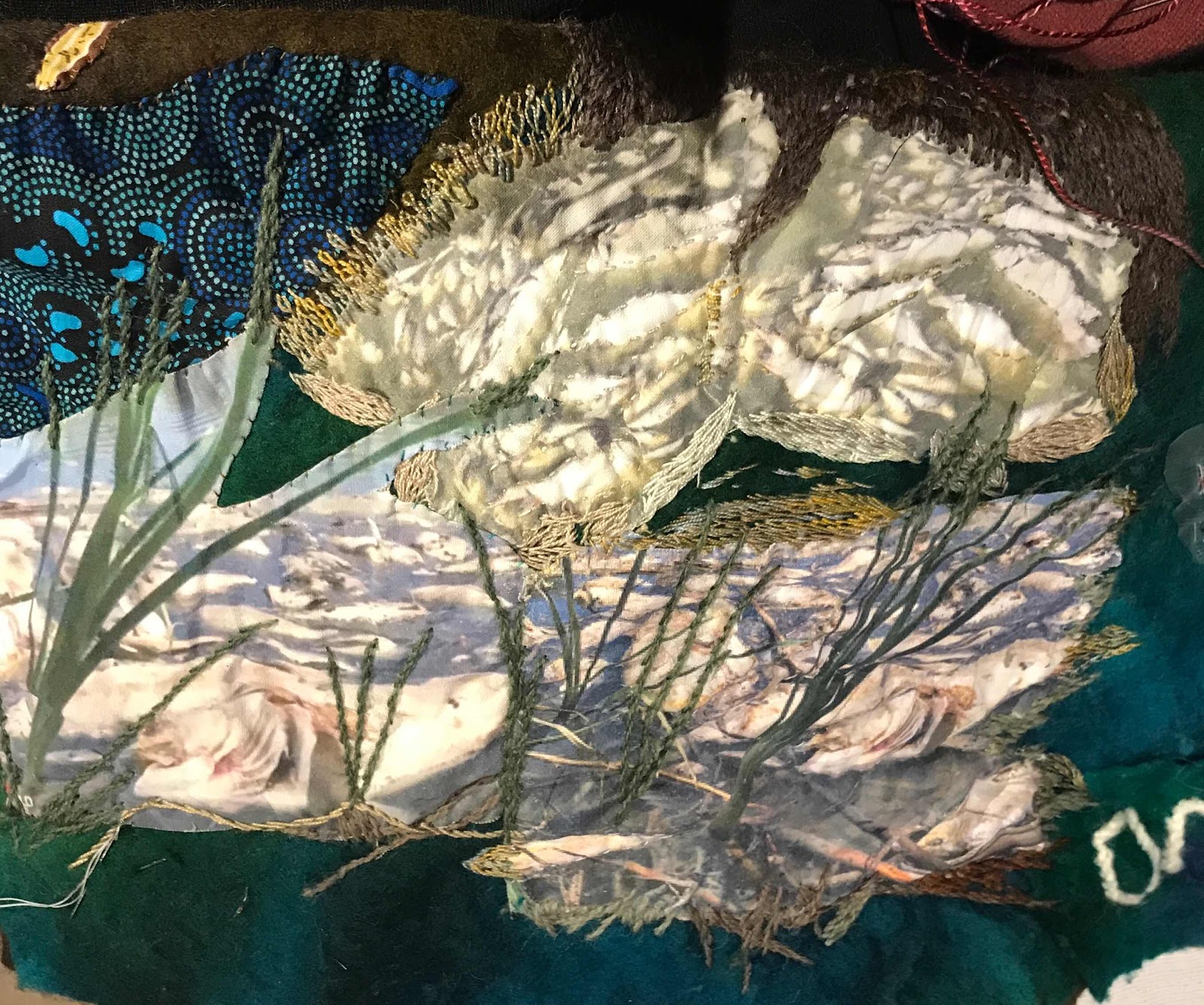 I needed to add more dead fish so printed a couple more photos, incorporating them with embroidered edges and extending the reeds.While I was about it, I extending the reeds around the edge of the river on the right bank.
I needed to add more dead fish so printed a couple more photos, incorporating them with embroidered edges and extending the reeds.While I was about it, I extending the reeds around the edge of the river on the right bank.
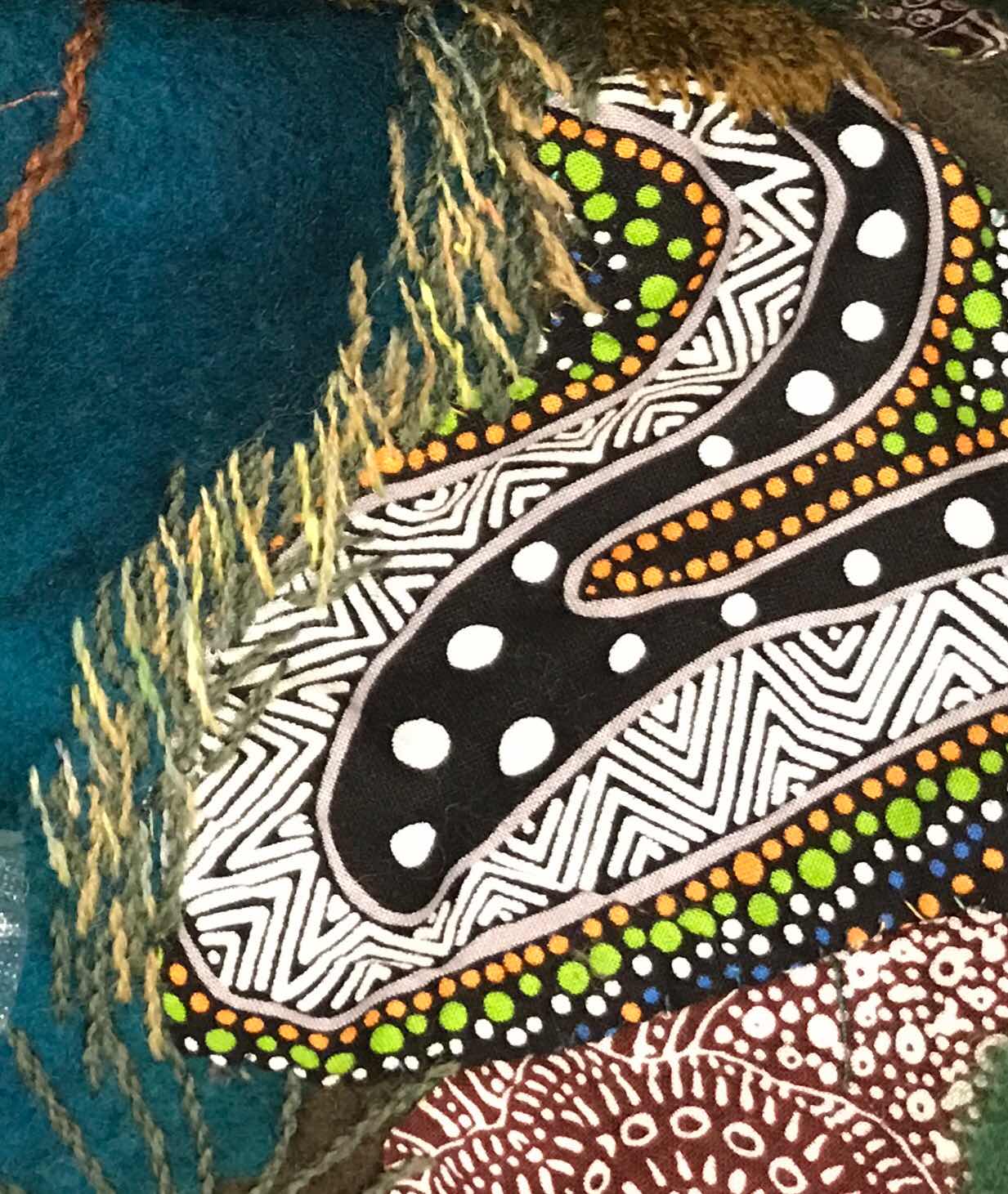
Somewhere along the way, I had watched an episode of Heather Ewart’s ABC TV series Back Roads, in which she visited the Riverland. Right at the end, a farmer commented that “the river matters”. It stuck in my head and became the title of this embroidery.
I tried embroidering the title on the river, using Quaker stitch and some lovely variegated reddy-brown thread. To try to keep it straight and even I once again used Solvi.
I was disappointed in the result. The words were lost in the felt.
 On the other hand, I had a lot of fun adding orange trees - needle felting the tops, (Veronica helped out here) embroidering the trunks with stem and Bokhara stitch and adding French knot oranges in varying shades of green to orange.
On the other hand, I had a lot of fun adding orange trees - needle felting the tops, (Veronica helped out here) embroidering the trunks with stem and Bokhara stitch and adding French knot oranges in varying shades of green to orange.
Throughout this process I shared my progress with my regular stitching friends whose opinions helped a lot as I decided what to include or leave out.
I had a couple of attempts at adding some grapes and grapevine to the riverbank. I tried creating grapes from felt - but couldn’t get the definition I wanted.
 Eventually I remembered my collection of iron-on transfers. I found a book of transfers that included a grapevine! I ironed sections of it on to linen, embroidered the linen, then appliqued this to the felt.
Eventually I remembered my collection of iron-on transfers. I found a book of transfers that included a grapevine! I ironed sections of it on to linen, embroidered the linen, then appliqued this to the felt.
Satisfaction at last! It worked, though it wasn’t an easy process. The layers were, by now, quite thick and the linen edges frayed. I needed to go around the edges with French knots to cover stray linen strands. This time, the reddy-brown thread worked well for the grapes!

Having rediscovered my iron-on transfers, I used a 1970s Hobbytex one of an ibis to create a banner on linen, adding the title text in Quaker stitch.
This gave the prominence I was after. The top of the banner is appliqued with French knots, blending with the dots on the fabric. The bottom edge is stitched with detached fly to continue the ibis’s footprint.
Appliqued animals add, I hope, a further sense of what we owe to the river.
It was time to turn my attention to the backing of the piece. Because I want this to be in some way a useful object, rather than a picture on a wall, I had conceived it as a small blanket or rug. I needed to keep it soft and flexible. The felt fabric is wonderfully soft, but won’t take hard wear.
My original intention was to back it with another felt flimsy, then bind the edge using cotton fabric depicting fish, turtles and other sea creatures - creating the idea of an island - the land and the river surrounded by life-giving oceans.
However, in order to get the edges straight I would need to square off the felt, which I couldn’t do without losing some content. I discussed this with some members of the World Embroidery Study (WES) Group, who suggested the edge should be as dynamic as the river.
I wanted to use some appliqued panels of Spirits on the back, along with a Rainbow Serpent, who, after all, created the river. I really wanted to use the Spirits - hoping, I guess, that they ‘have the back’ of the river. A double layer of felt flimsy would make a great rug, but not an even edge.
I went ahead and added the Spirits to the felt flimsy called “Federation”. I love the colours, and I also like the symbolism of federation - a difficult process, but one that gives all of us an obligation to the river system.

I backed them with iron-on fusible webbing, ironed them on, then stitched around the edges of each piece with French knots. It worked a treat on these fabrics.
I was then left with the challenge of putting the two pieces together. One suggestion from the WES Group was to layer the piece on to black, but to do this, I would need to put black fabric between the two flimsies and either needle-felt or applique the flimsies to the black.
 After quite a bit of thought and experiment I decided to try to fold the back edge over the front and stitch it down with a fly stitch - more bird tracks!
After quite a bit of thought and experiment I decided to try to fold the back edge over the front and stitch it down with a fly stitch - more bird tracks!
The process of stretching the back edge over the front was not easy. I managed it on three sides, then added a strip from another flimsy to complete the last side. I used some lovely hand-dyed thread from the Stitchy Box subscription given to me by my daughter in 2017.
I am pretty pleased with
the result. The piece is wonderfully soft to hold. I hope I have done justice to the river - and to its importance to
those who live along its banks and care for it.
I have turned this blog into a booklet that I submitted as part of the Exhibition entry.
Acknowledgements and Resources
There are still numerous
Aboriginal language speaking groups along the Murray River (though nowhere near as many as there were before white settlement), including the Ngarrindgeri
in South Australia and Yorta
Yorta near Echuca in Victoria. They have cared for the river for tens of thousands of years and continue to do so.A helpful map and information can be found
at http://www.murrayriver.com.au/about-the-murray/murray-river-aboriginals/
Fabric for this project
came from:
The fabric
is Dancing Spirit Brown by Colleen Wallace, Possum Land and Water Blue by
Heather Kennedy, On Walkabout Blue by Karen Taylor, Waterhole Brown by Arma
Price Pitjara and Snake Emu Charcoal by W Evans.
The felt flimsies came from The
Thread Studio, 6 Smith Street Perth, WA 6000
Some of the threads were from those
sent to me in 2017 as part of a Stitchy Box monthly subscription given to me as
a gift by my daughter. https://shop.stitchybox.com/
Photos of dead fish on Menindee
Lakes were from:
The Daily Telegraph,
Jeremy Buckingham, Ex-Greens MP Inspects
Darling River Fish Kill 19 January 2019
Members of the World Embroidery
Study Group of the Embroiderers’ Guild of SA provided suggestions and feedback,
as did Susan Butler, Jennifer Stehn and my family.
